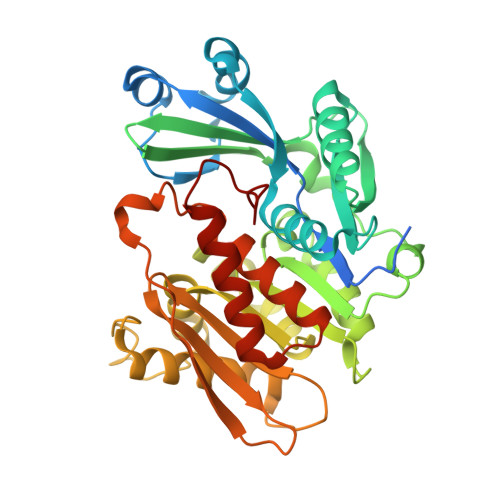Substrate analogs induce an intermediate conformational change in Toxoplasma gondii adenosine kinase
Zhang, Y., El Kouni, M.H., Ealick, S.E.(2007) Acta Crystallogr D Biol Crystallogr 63: 126-134
- PubMed: 17242506
- DOI: https://doi.org/10.1107/S0907444906043654
- Primary Citation of Related Structures:
2A9Y, 2A9Z, 2AA0, 2AB8 - PubMed Abstract:
Adenosine kinase (AK) is a key enzyme in purine metabolism in the ubiquitous intracellular parasite Toxoplasma gondii and is a potential chemotherapeutic target for the treatment of T. gondii infections. To better understand the structure-activity relationship of 6-substituted purine ribosides, the structures of the T. gondii AK-N6,N6-dimethyladenosine (DMA) complex, the AK-DMA-AMP-PCP complex, the AK-6-methyl mercaptopurine riboside (MMPR) complex and the AK-MMPR-AMP-PCP complex were determined to 1.35, 1.35, 1.75 and 1.75 A resolution, respectively. These structures reveal a conformation intermediate between open and closed, with a small lid-domain rotation of 12 degrees . Residues Gly143-X-X-Gly146 undergo torsional changes upon substrate binding, which together with a Gly68-Gly69 switch induces a hinge bending of the lid domain. The intermediate conformation suggests that ATP binding is independent of adenosine binding. Orienting the gamma-phosphate group of ATP into the optimal catalytic position may be the last step before the onset of chemical catalysis and may require the translocation of Arg136 following the complete closure of the lid domain. 6-Substituted purine-nucleoside analogs are accommodated in a hydrophobic cavity. Modification at the N6 or C6 position of the nucleoside would affect the interactions with the surrounding residues and the binding affinity.
- Department of Molecular Biology and Genetics, Cornell University, Ithaca, NY 14853, USA.
Organizational Affiliation:




















